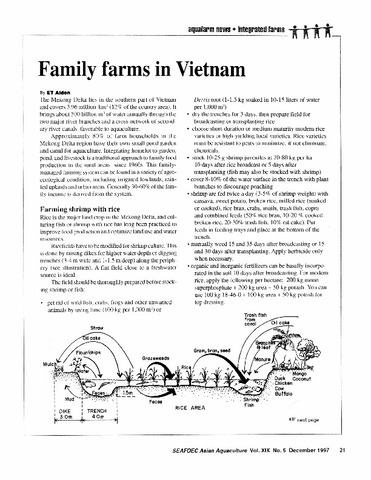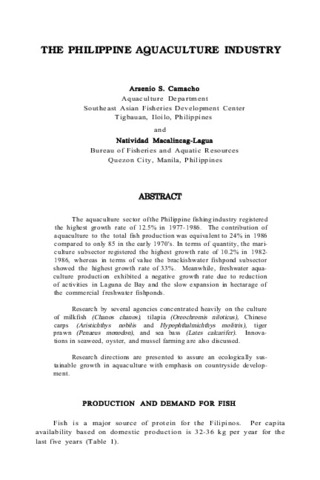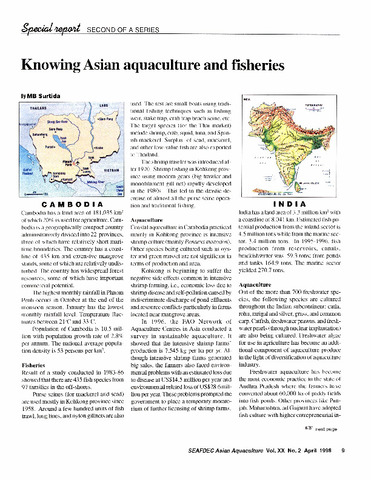| dc.contributor.author | Flores, Rudy C. | |
| dc.contributor.author | Tungol, Felicisima E. | |
| dc.contributor.author | Antonio, Abraham S. | |
| dc.contributor.author | Medairos, Elizabeth D. | |
| dc.contributor.author | Salas, Jonathan M. | |
| dc.contributor.editor | Romana-Eguia, Maria Rowena R. | |
| dc.contributor.editor | Parado-Estepa, Fe D. | |
| dc.contributor.editor | Salayo, Nerissa D. | |
| dc.contributor.editor | Lebata-Ramos, Ma. Junemie Hazel | |
| dc.date.accessioned | 2016-01-19T10:02:06Z | |
| dc.date.available | 2016-01-19T10:02:06Z | |
| dc.date.issued | 2015 | |
| dc.identifier.citation | Flores, R. C., Tungol, F. E., Antonio, A. S., Medairos, E. D., & Salas, J. M. (2015). BFAR-CHED Philippine National Aquasilviculture Program (PNAP) in Bataan. In M. R. R. Romana-Eguia, F. D. Parado-Estepa, N. D. Salayo, & M. J. H. Lebata-Ramos (Eds.), Resource Enhancement and Sustainable Aquaculture Practices in Southeast Asia: Challenges in Responsible Production of Aquatic Species: Proceedings of the International Workshop on Resource Enhancement and Sustainable Aquaculture Practices in Southeast Asia 2014 (RESA) (pp. 169-188). Tigbauan, Iloilo, Philippines: Aquaculture Dept., Southeast Asian Fisheries Development Center. | en |
| dc.identifier.isbn | 9789719931041 | |
| dc.identifier.uri | http://hdl.handle.net/10862/2772 | |
| dc.description.abstract | Under the Philippine Aquasilviculture Program, the Bataan Peninsula State University (BSPU) rehabilitated denuded mangrove resources, established aquasilviculture technology demonstration projects as a livelihood option for fisherfolks (while caring for the mangroves they had planted) and established community-based multi-species hatcheries to increase endemic fish species in the area.
The BPSU was able to (a) plant 183, 300 mangrove seedlings where 85.96% survival was noted a year after, (b) establish 16 units aquasilviculture projects for the livelihood of the beneficiaries (planting that earned the beneficiaries P1,338, 731.90); and (c) establish community-based multispecies hatcheries that already produced an estimated 1,030,502,400 eggs of various fish species, thus increasing the wild fishery resource in the area.
The program is expected to bear potential impacts on our environment and to the lives of the marginalized people of our community through the collaborative efforts of the Bureau of Fisheries and Aquatic Resources (BFAR), the Commission on Higher Education (CHED), BPSU, Local Government Units (LGUs) and the fisherfolks. | en |
| dc.language.iso | en | en |
| dc.publisher | Aquaculture Department, Southeast Asian Fisheries Development Center | en |
| dc.subject | Philippines | en |
| dc.subject | hatcheries | en |
| dc.title | BFAR-CHED Philippine National Aquasilviculture Program (PNAP) in Bataan | en |
| dc.type | Conference paper | en |
| dc.citation.spage | 169 | |
| dc.citation.epage | 188 | |
| dc.subject.asfa | community planning | en |
| dc.subject.asfa | resource management | en |
| dc.subject.asfa | resource conservation | en |
| dc.subject.asfa | brackishwater aquaculture | en |
| dc.subject.asfa | environmental protection | en |
| dc.subject.asfa | livelihoods | en |
| dc.subject.asfa | research programmes | en |
| dc.subject.asfa | endemic species | en |
| dc.subject.asfa | socioeconomic aspects | en |
| dc.subject.asfa | aquaculture development | en |
| dc.subject.asfa | aquaculture techniques | en |
| dc.subject.asfa | mangroves | en |
| dc.citation.conferenceTitle | Resource Enhancement and Sustainable Aquaculture Practices in Southeast Asia: Challenges in Responsible Production of Aquatic Species: Proceedings of the International Workshop on Resource Enhancement and Sustainable Aquaculture Practices in Southeast Asia 2014 (RESA) | en |



